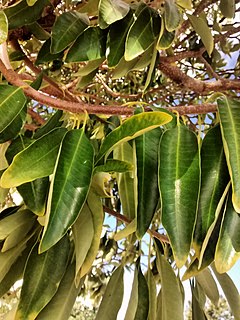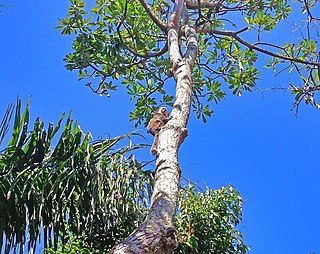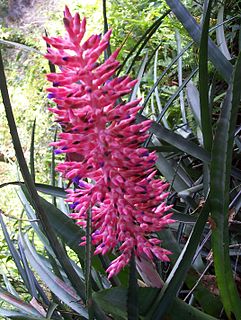
Aspidosperma cylindrocarpon is a timber tree native to Brazil, Paraguay, Bolivia, and Peru. It is common in Atlantic Forest, Cerrado and Pantanal vegetation of Brazil. This plant is cited in Flora Brasiliensis by Carl Friedrich Philipp von Martius. In addition, it is useful for beekeeping.

Aspidosperma macrocarpon is a timber tree native to Brazil, Venezuela, Bolivia, Paraguay, and Peru. It is common in Cerrado vegetation. It has a self-supporting growth form with simple, broad leaves. This plant is cited in Flora Brasiliensis by Carl Friedrich Philipp von Martius, and it is useful for beekeeping. Individual plants can grow up to 25 m.

Aspidosperma parvifolium is a timber tree native to Brazil, which is typical of Atlantic Forest, Cerrado, Caatinga, and Pantanal vegetation. This plant is cited in Flora Brasiliensis by Carl Friedrich Philipp von Martius. In addition, it is useful for beekeeping.

Aspidosperma polyneuron is a timber tree native to Brazil, Colombia, Peru, Argentina, and Paraguay. It is common in Atlantic Forest vegetation. In addition, it is useful for beekeeping.
Aspidosperma ramiflorum is a timber tree native to Brazil and Bolivia.

Aspidosperma tomentosum is a timber tree native to Brazil, Bolivia, and Paraguay. It is common in of Cerrado vegetation in Brazil. It was first described by Carl Friedrich Philipp von Martius.
Aspidosperma polyneuron is a timber tree native to Brazil. It is common in Atlantic Forest vegetation. In addition, it is useful for beekeeping.

Aspidosperma australe is a timber tree native to Brazil, Argentina, Bolivia, and Paraguay.
Aspidosperma olivaceum is a timber tree native to SE Brazil. It is common in Atlantic Forest, Cerrado, Caatinga, and Pantanal vegetation.

Hancornia is a genus of flowering plant in the family Apocynaceae, first described as a genus in 1812. It is native to South America. It contains only one known species, Hancornia speciosa, commonly called mangabeira, which produces fruits known as mangabas.

Himatanthus is a genus of flowering plant in the family Apocynaceae, first described as a genus in 1819. It is native to Panama and South America.
- Himatanthus articulatus(Vahl) Woodson - widespread from Panama east to French Guiana and south to Bolivia
- Himatanthus attenuatus(Benth.) Woodson - Venezuela, Colombia, N Brazil
- Himatanthus bracteatus(A.DC.) Woodson - Venezuela, Colombia, Guianas, Brazil, Peru, Ecuador
- Himatanthus drasticus(Mart.) Plumel - Guianas, Brazil
- Himatanthus lancifolius(Müll.Arg.) Woodson
- Himatanthus obovatus(Müll.Arg.) Woodson - Brazil, Bolivia, Guyana
- Himatanthus phagedaenicus(Mart.) Woodson - S Venezuela, NW Brazil
- Himatanthus semilunatusMarkgr. - Amazon Basin
- Himatanthus stenophyllusPlumel - Colombia, NW Brazil, Guyana, Suriname
- Himatanthus tarapotensis(K.Schum. ex Markgr.) Plumel - Colombia, Bolivia, Brazil, Peru, Ecuador

Aechmea bromeliifolia is a bromeliad native to southern Mexico, Central America, Trinidad, and South America as far south as northern Argentina.

Aechmea nudicaulis is a bromeliad species in the genus Aechmea, which is often used as an ornamental plant. This species is native to Central America, the West Indies, central and southern Mexico, and northern and central South America.

Aechmea distichantha, the Brazilian vaseplant, or vase plant, is a bromeliad typical of Cerrado vegetation in Brazil, which is also native to northern Argentina, Bolivia, Paraguay, and Uruguay. This plant is often used as an ornamental plant.

Mario Guimarães Ferri was a Professor at the Universidade de São Paulo (USP). He was a research scientist, a lecturer, an editor, an administrator and also an artist. In his scientific work, he was a pioneer ecologist in Brazil. His power of communication linked to a great love of botany and the environment and a deep scientific knowledge made of him an exceptional lecturer. In his books and articles on science he informed the public about ecology and pollution – and in a very simple but precise language he presented the necessary data to understand the importance of the protection of the environment.

Aechmea coelestis is a species in the genus Aechmea. This is a species that is native to southeastern Brazil from Espírito Santo to Santa Catarina.
Aechmea bocainensis is a species of plant in the genus Aechmea. This species is endemic to Brazil, found in the States of Rio de Janeiro and São Paulo.
Aechmea organensis is a plant species in the genus Aechmea. This species is endemic to southeastern Brazil.

Tillandsia geminiflora is a species in the genus Tillandsia. This species is native to Brazil, Suriname, Paraguay, Uruguay, and the Misiones Province of Argentina.
Rhaphiodon echinus is a species of flowering plant in the family Lamiaceae, endemic to eastern Brazil. It is the only known species in the genus Rhaphiodon, first described as a plant genus in 1844.














